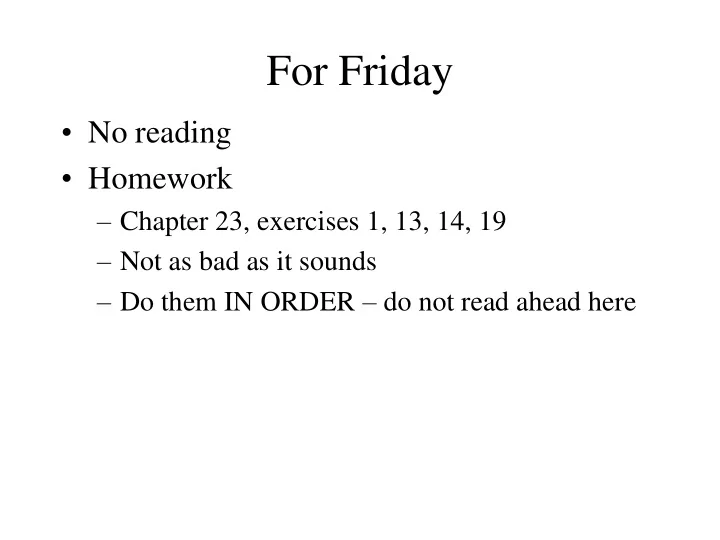

For Friday • No reading • Homework – Chapter 23, exercises 1, 13, 14, 19 – Not as bad as it sounds – Do them IN ORDER – do not read ahead here
Program 5 • Any questions?
Speech Recognition Demo
Syntax Demos • http://www2.lingsoft.fi/cgi-bin/engcg • http://nlp.stanford.edu:8080/parser/index.jsp • http://teemapoint.fi/nlpdemo/servlet/ParserS ervlet • http://www.link.cs.cmu.edu/link/submit- sentence-4.html
Language Identification • http://rali.iro.umontreal.ca/
Semantics • Most work probably hand-constructed systems • Some more interested in developing the semantics than the mappings • Basic question: what constitutes a semantic representation? • Answer may depend on application???
Possible Semantic Representations • Logical representation • Database query • Case grammar
Distinguishing Word Senses • Use context to determine which sense of a word is meant • Probabilistic approaches • Rules • Issues – Obtaining sense-tagged corpora – What senses do we want to distinguish?
Semantic Demos • http://www.cs.utexas.edu/users/ml/geo.html • http://www.ling.gu.se/~lager/Mutbl/demo.ht ml
Information Retrieval • Take a query and a set of documents. • Select the subset of documents (or parts of documents) that match the query • Statistical approaches – Look at things like word frequency • More knowledge based approaches interesting, but maybe not helpful
Information Extraction • From a set of documents, extract “interesting” pieces of data • Hand-built systems • Learning pieces of the system • Learning the entire task (for certain versions of the task) • Wrapper Induction
IE Demos • http://nlp.i2r.a-star.edu.sg/demo_ie.html • http://services.gate.ac.uk/annie/
Question Answering • Given a question and a set of documents (possibly the web), find a small portion of text that answers the question. • Some work on putting answers together from multiple sources.
QA Demo • http://demos.inf.ed.ac.uk:8080/qualim/
Text Mining • Outgrowth of data mining. • Trying to find “interesting” new facts from texts. • One approach is to mine databases created using information extraction.
Pragmatics • Distinctions between pragmatics and semantics get blurred in practical systems • To be a practically useful system, some aspects of pragmatics must be dealt with, but we don’t often see people making a strong distinction between semantics and pragmatics these days. • Instead, we often distinguish between sentence processing and discourse processing
What Kinds of Discourse Processing Are There? • Anaphora Resolution – Pronouns – Definite noun phrases • Handling ellipsis • Topic • Discourse segmentation • Discourse tagging (understanding what conversational “moves” are made by each utterance)
Approaches to Discourse • Hand-built systems that work with semantic representations • Hand-built systems that work with text (or recognized speech) or parsed text • Learning systems that work with text (or recognized speech) or parsed text
Issues • Agreement on representation • Annotating corpora • How much do we use the modular model of processing?
Pronoun Resolution Demo • http://www.clg.wlv.ac.uk/demos/MARS/ind ex.php
Summarization • Short summaries of a single text or summaries of multiple texts. • Approaches: – Select sentences – Create new sentences (much harder) – Learning has been used some but not extensively
Machine Translation • Best systems must use all levels of NLP • Semantics must deal with the overlapping senses of different languages • Both understanding and generation • Advantage in learning: bilingual corpora exist--but we often want some tagging of intermediate relationships • Additional issue: alignment of corpora
Approaches to MT • Lots of hand-built systems • Some learning used • Probably most use a fair bit of syntactic and semantic analysis • Some operate fairly directly between texts
Generation • Producing a syntactically “good” sentence • Interesting issues are largely in choices – What vocabulary to use – What level of detail is appropriate – Determining how much information to include
Recommend
More recommend